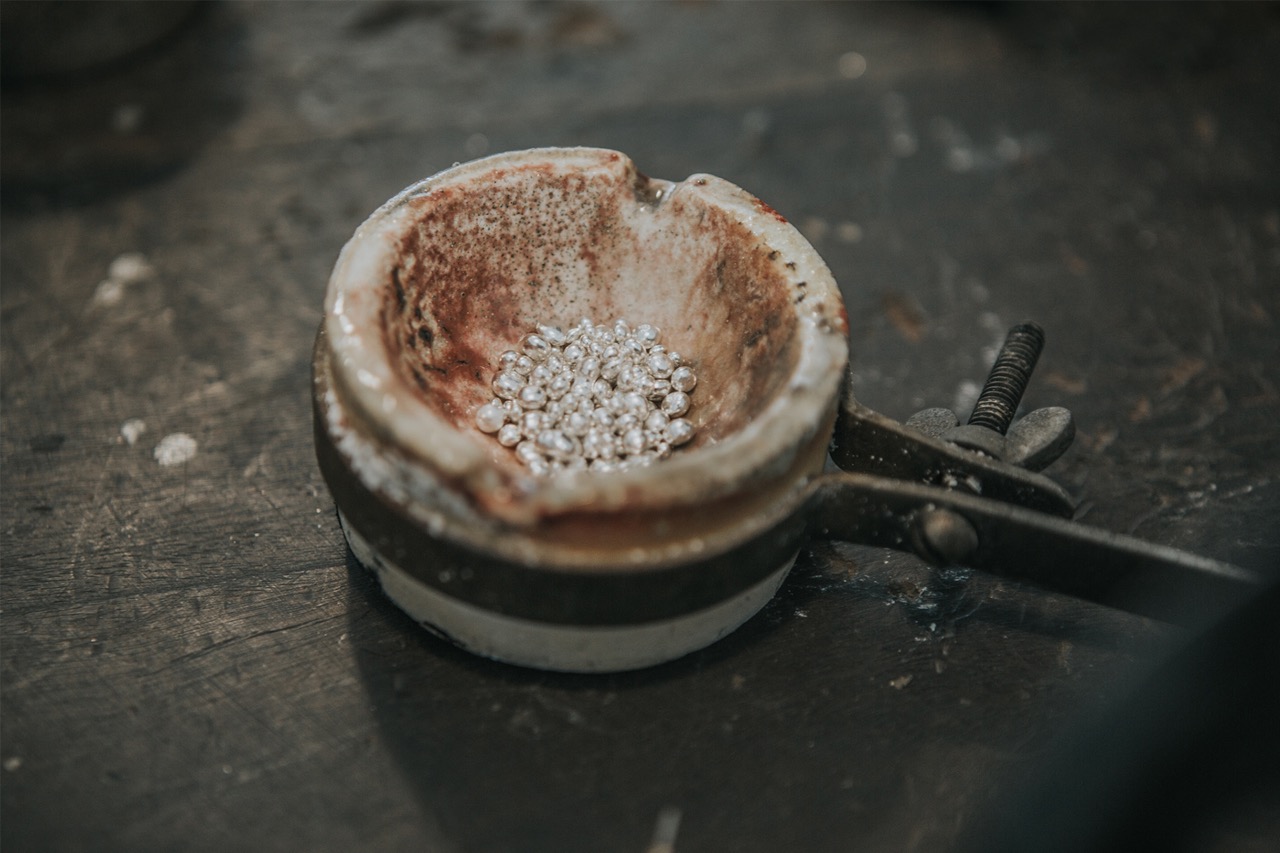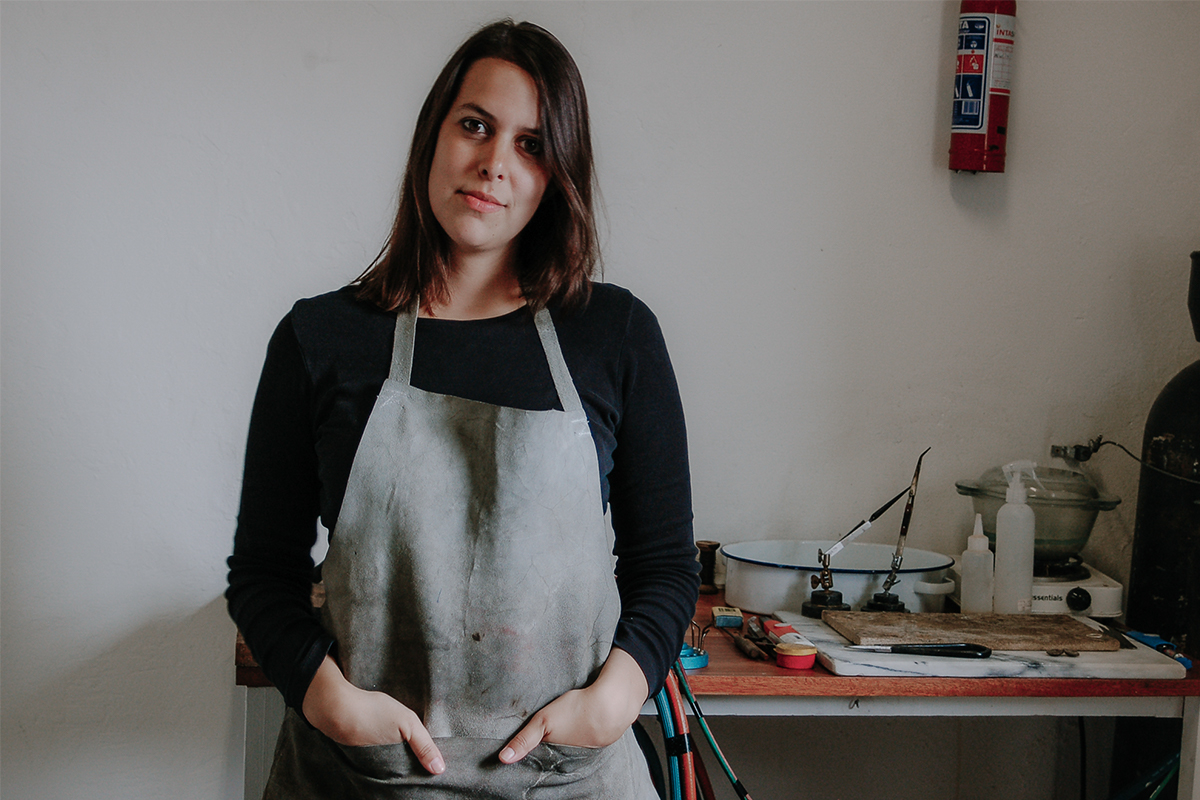Ashley Heather, founder of AuTerra, walks us through the philosophy behind a model of jewelry production that aims to return to a concept of ‘slow fashion’
The Origins of AuTerra
AuTerra is a small South African jewelry business founded in the aftermath of a part-time jewelry course Ms. Heather, the founder, took to filling in her spare time. Her background, at the time, was in sustainability and food security. She points out that reconciling her newfound passion for jewelry and her original drive to protect natural resources left her at a crossroads where she saw «no natural path».
Things took a turn when she came across some old photographs wasted in the unused half of her grandparent’s garage. Having studied fine arts, Ms. Heather knew that she could find silver within old cameras and so she decided to take a gamble.
The journey was not easy, she says, as darkroom photography was and is still much a dying art. So she started exploring alternative ways of sourcing metals from solid waste. In 2015, Ms. Heather gathered a small team together and inaugurated AuTerra, partnering with an e-waste provider to create the first gold ring made out of electronic waste at the time. Eleven years down the line, AuTerra now specializes in crafting jewelry using precious metals reclaimed from a small refinery local to the region in Cape Town, South Africa.
‘Slow fashion’ production and consumption
AuTerra is committed to moving towards a conceptual model of production and consumption defined by «slow fashion». For this to happen the company aims to create jewelry that their customers can appreciate as an heirloom. Ms. Heather refers to these as «pieces that are then passed down» as opposed to the ‘throw-away culture’, that has been gaining strength more recently, in things like cheap nickel pieces.
According to Ms. Heather, the business strives «to make pieces that people buy to commemorate special moments in their lives or things that carry with them a little bit of a story that they’re not just going to discard. It’s more than just an object».
Ethical sourcing and processing of materials
Such a model of business entails, as Ms. Heather points out, intentionality in terms of the production and consumption of jewelry. This intentionality starts with the ethical sourcing and processing of materials and extends itself to customers who are invited to symbolically mark their stories with a piece of jewelry made to last down the family line.
Ms. Heather highlights the value of jewelry’s power to tell a story. The story of its production (the origin and processing of materials) as well as the personal story embedded into the piece of jewelry by the purchasing customers. The company, therefore, seeks to reclaim a healthier relationship with natural resources whilst inspiring conscious consumption.
Au Terra going circular with jewelry
Jewelry is, as Ms. Heather explains, circular by nature since precious metals like silver and gold are valuable and durable materials. The likelihood is that they will be reused, in contrast to other metal products like fizzy drink cans that are commonly discarded on a daily basis.
She does note, however, that the rise of the fast fashion industry has brought this into question by establishing a market for jewelry products that are designed to be discarded within a relatively short time frame. Ms. Heather hints at the value of considering circularity not just in terms of the material itself as per the traditional model of jewelry manufacturing. But she also emphasizes the need to think in terms of the process and resources that take part in the production of jewelry.
The process of extraction and refining
For that, the company’s resources need to flow circularly also, including the process of extraction and refining. AuTerra embeds circularity into its mode of production via several methods. During the production phase, the company opts for a closed-looped water system where water is recycled continuously and used to make several pieces of jewelry rather than being discarded after each cycle.
On the packaging side of things, the business was using locally sourced hemp, but new government regulations meant that the material was no longer available. So the company now uses organic linen, although this is not available within the country as Ms. Heather points out. When it comes to final details, AuTerra is dedicated to presenting their care instructions on 100% recycled paper, using vegetable ink.
The value of a small work community
Ms. Heather advocates community as one of the core principles that drive AuTerra. She states that sustainability is challenging and that it is only by working together in a community that progress can be achieved. For her, such a community includes the immediate members of her team, but also extends itself to the network of e-waste aggregators and refinery partners that are affiliated with the company.
Cutting down on the carbon footprint that transportation entails
The business sources most of its e-waste locally within South Africa and a little from the neighboring countries of Botswana and Zimbabwe. The purpose of this is to cut down on the carbon footprint that transportation entails. Ms. Heather says that transportation is a tricky one when it comes to thinking ecologically since the responsibility for carbon emissions lies with third-party couriers.
By keeping things local, Ms. Heather hopes to minimize the carbon footprint associated with transportation. She also believes in the importance of keeping the value of e-waste circulating within and for the local economy. Beyond the finished jewelry product, she claims that there is little the company can do to cut and reduce carbon emissions, other than dialogue with affiliate couriers about adopting eco-friendly packaging like bags made out of corn rather than plastic. It is all an ongoing process that requires dialogue and willingness amongst local businesses.
Community also takes place at a micro level within the company itself. AuTerra highlights the need to build its team «up rather than outwards». It’s not about the numbers within the company, but rather about strengthening the existing relationships to generate quality jewelry from a well-thought and circular model of production which requires space for trial and error.
Mindfulness at Work
Creating an alternative mode of business is also accompanied by settling for an alternative mindset. Ms. Heather explains that different businesses have different models that work for each company and that all play an important role in creating the panoramic view of a regenerative system. But her pledge to a model of business that nurtures a healthy relationship between the natural environment and human beings is all about ‘mindfulness.’
Presence is key in the process. It is by means of that presence that Ms. Heather and her team can find new and innovative solutions rather than defaulting to the auto-pilot way of running a business. She elaborates on this point by stating that being present means that she and her team are paying attention to their work, which allows them to do things a little better than yesterday. She says that this presence can manifest through something as simple as tying a string together in a slightly different way in order to economize on the primary material.
The process is about moving slowly and allowing things to change and improve gradually. The concept of slow fashion extends itself to slow production within the workplace, placing dedication, creative thinking, and freedom above the need for large-scale production.
Next steps for Au Terra
Ms. Heather decides to stay true to the company’s philosophy of presence when telling us about their next steps. She explains that « next steps are often not apparent until we are standing at a crossroad making decisions between two things».
For now, she explains, the company’s immediate steps are to stay the course and keep doing what they are already doing with the aim to scale-up e-waste processing operations in order to recycle more materials and turn them into jewelry. The goal is to do a little bit more every day, focusing on building their team by following a model of growth that is dictated by the quality of relationships and production rather than quantity.
Au Terra
A small company in South Africa that pledges to reconcile the jewelry industry with ecological principles by repurposing precious metals from electronic e-waste. They aim to create valuable pieces of jewelry by defining value in terms of durability and quality. Their work is minimalist but well-thought and creative, a result of close-knit community and mindfulness values, driven by the concept of « slow fashion».




















